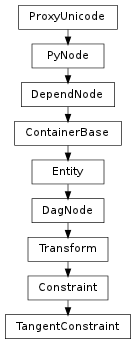pymel.core.nodetypes.TangentConstraint¶

- class TangentConstraint(*args, **kwargs)¶
class counterpart of mel function tangentConstraint
Constrain an object’s orientation based on the tangent of the target curve[s] at the closest point[s] to the object. A tangentConstraint takes as input one or more NURBS curves (the targets) and a DAG transform node (the object). The tangentConstraint orients the constrained object such that the aimVector (in the object’s local coordinate system) aligns in world space to combined tangent vector. The upVector (again the the object’s local coordinate system) is aligned in world space with the worldUpVector. The combined tangent vector is a weighted average of the tangent vector for each target curve at the point closest to the constrained object.
- getAimVector(**kwargs)¶
Set the aim vector. This is the vector in local coordinates that points at the target. If not given at creation time, the default value of (1.0, 0.0, 0.0) is used.
Derived from mel command maya.cmds.tangentConstraint
- getName(**kwargs)¶
Sets the name of the constraint node to the specified name. Default name is constrainedObjectName_constraintType
Derived from mel command maya.cmds.tangentConstraint
- getTargetList(**kwargs)¶
Return the list of target objects.
Derived from mel command maya.cmds.tangentConstraint
- getUpVector(**kwargs)¶
Set local up vector. This is the vector in local coordinates that aligns with the world up vector. If not given at creation time, the default value of (0.0, 1.0, 0.0) is used.
Derived from mel command maya.cmds.tangentConstraint
- getWeightAliasList(**kwargs)¶
Returns the names of the attributes that control the weight of the target objects. Aliases are returned in the same order as the targets are returned by the targetList flag
Derived from mel command maya.cmds.tangentConstraint
- getWorldUpObject(**kwargs)¶
Set the DAG object use for worldUpType “object” and “objectrotation”. See worldUpType for greater detail. The default value is no up object, which is interpreted as world space.
Derived from mel command maya.cmds.tangentConstraint
- getWorldUpType(**kwargs)¶
Set the type of the world up vector computation. The worldUpType can have one of 5 values: “scene”, “object”, “objectrotation”, “vector”, or “none”. If the value is “scene”, the upVector is aligned with the up axis of the scene and worldUpVector and worldUpObject are ignored. If the value is “object”, the upVector is aimed as closely as possible to the origin of the space of the worldUpObject and the worldUpVector is ignored. If the value is “objectrotation” then the worldUpVector is interpreted as being in the coordinate space of the worldUpObject, transformed into world space and the upVector is aligned as closely as possible to the result. If the value is “vector”, the upVector is aligned with worldUpVector as closely as possible and worldUpMatrix is ignored. Finally, if the value is “none” no twist calculation is performed by the constraint, with the resulting “upVector” orientation based previous orientation of the constrained object, and the “great circle” rotation needed to align the aim vector with its constraint. The default worldUpType is “vector”.Flag can appear in Create mode of commandFlag can have multiple arguments, passed either as a tuple or a list.
Derived from mel command maya.cmds.tangentConstraint
- getWorldUpVector(**kwargs)¶
Set world up vector. This is the vector in world coordinates that up vector should align with. See -wut/worldUpType (below)for greater detail. If not given at creation time, the default value of (0.0, 1.0, 0.0) is used.
Derived from mel command maya.cmds.tangentConstraint
- layer(val=True, **kwargs)¶
Specify the name of the animation layer where the constraint should be added.
Derived from mel command maya.cmds.tangentConstraint
- remove(val=True, **kwargs)¶
removes the listed target(s) from the constraint.
Derived from mel command maya.cmds.tangentConstraint
- setAimVector(val=True, **kwargs)¶
Set the aim vector. This is the vector in local coordinates that points at the target. If not given at creation time, the default value of (1.0, 0.0, 0.0) is used.
Derived from mel command maya.cmds.tangentConstraint
- setName(val=True, **kwargs)¶
Sets the name of the constraint node to the specified name. Default name is constrainedObjectName_constraintType
Derived from mel command maya.cmds.tangentConstraint
- setUpVector(val=True, **kwargs)¶
Set local up vector. This is the vector in local coordinates that aligns with the world up vector. If not given at creation time, the default value of (0.0, 1.0, 0.0) is used.
Derived from mel command maya.cmds.tangentConstraint
- setWorldUpObject(val=True, **kwargs)¶
Set the DAG object use for worldUpType “object” and “objectrotation”. See worldUpType for greater detail. The default value is no up object, which is interpreted as world space.
Derived from mel command maya.cmds.tangentConstraint
- setWorldUpType(val=True, **kwargs)¶
Set the type of the world up vector computation. The worldUpType can have one of 5 values: “scene”, “object”, “objectrotation”, “vector”, or “none”. If the value is “scene”, the upVector is aligned with the up axis of the scene and worldUpVector and worldUpObject are ignored. If the value is “object”, the upVector is aimed as closely as possible to the origin of the space of the worldUpObject and the worldUpVector is ignored. If the value is “objectrotation” then the worldUpVector is interpreted as being in the coordinate space of the worldUpObject, transformed into world space and the upVector is aligned as closely as possible to the result. If the value is “vector”, the upVector is aligned with worldUpVector as closely as possible and worldUpMatrix is ignored. Finally, if the value is “none” no twist calculation is performed by the constraint, with the resulting “upVector” orientation based previous orientation of the constrained object, and the “great circle” rotation needed to align the aim vector with its constraint. The default worldUpType is “vector”.Flag can appear in Create mode of commandFlag can have multiple arguments, passed either as a tuple or a list.
Derived from mel command maya.cmds.tangentConstraint
- setWorldUpVector(val=True, **kwargs)¶
Set world up vector. This is the vector in world coordinates that up vector should align with. See -wut/worldUpType (below)for greater detail. If not given at creation time, the default value of (0.0, 1.0, 0.0) is used.
Derived from mel command maya.cmds.tangentConstraint